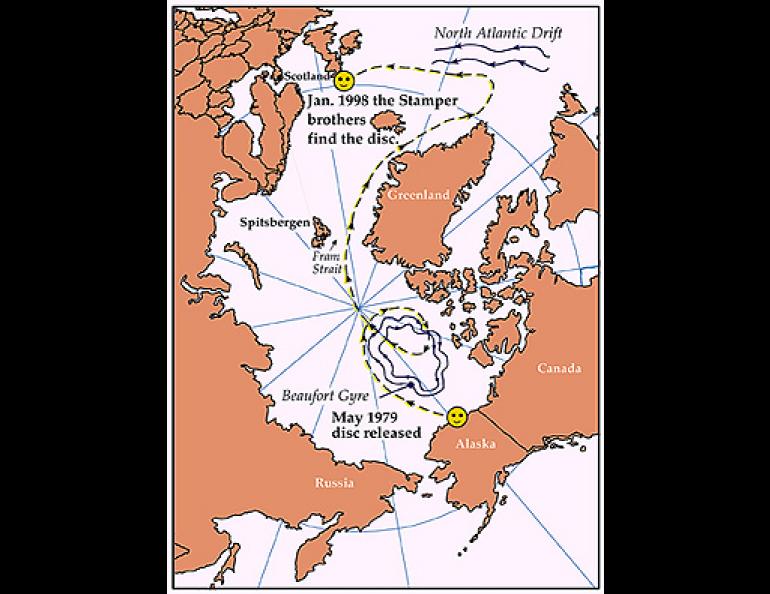
The Tale of a Far North Message in a Bottle
Calum Stamper and his brother Adam went for a walk on the beach recently near Calum's home on the Isle of Lewis, off the northwest coast of Scotland. As the brothers explored, seven-year old Calum saw what he thought was a Frisbee resting in a pile of rocks.
It wasn't a Frisbee, and that's where this turns into a science column. Adam Stamper, Calum's 15-year old brother, looked closely at the yellow disc. It was about seven inches in diameter and thin enough to fold easily. He turned it over and saw a typewritten message:
One Dollar Reward on Return of Serial Number with Date Found, Location, Your Name and Address to Geophysics Institute, Univ. of Alaska, Fairbanks.
Soon after the boys walked indoors, Adam turned on the computer and scanned the Internet. After a 30-minute search, Adam found the name of Don Rice, a project engineer here at the Geophysical Institute. Adam typed an e-mail message to Rice, and the mystery began to unravel.
It turns out the yellow disc traveled even farther than Adam's e-mail message. The disc was one of 1,500 scattered on Beaufort Sea ice in May, 1979. The discs, deployed at spots just east and west of Prudhoe Bay, were part of an experiment nicknamed "Drifter." Scientists wanted to see where the discs would end up in hopes of simulating what would happen to oil spilled on Beaufort Sea ice, which breaks up every year.
Many of the discs were recovered on beaches of Alaska's north slope, or islands just off the coast. But a few took a much longer ride, one that brings us back to two brothers playing on a Scotland beach.
Tom Weingartner, an oceanographer with UAF's Institute of Marine Science, described how the yellow disc No. 0093 most likely found its way to Calum Stamper's hand.
Envision the summer of 1979. Ice near the shore of the North Slope breaks up with a noise like distant thunder into ice floes, which separate like pieces of a jigsaw puzzle. The yellow disc hitches a ride on the back of a newborn ice floe. The ice floe carrying the yellow disc is caught in a clockwise circle of slow-moving ice, part of what scientists call the Beaufort Gyre. Caught in a giant loop, the disc spins near the North Pole for at least a decade.
Once spun out of the Arctic Ocean, the little disc travels on its raft of ice through the Fram Strait, a channel between Spitsbergen and Greenland that oceanographers study because it forms an important link from the Arctic Ocean to the North Atlantic Ocean. From there, powered by the East Greenland current, the ice floe hugs the east coast of Greenland.
By this time, the ice floe is approximately the same latitude as Nome, and moving south. Hitting warmer water and air, the ice melts, and the disc continues the journey alone by floating to the southern tip of Greenland, where it encounters the North Atlantic Drift. One year has passed since the disc first encountered Greenland.
The North Atlantic Drift, an extension of the Gulf Stream off the coast of the U.S., is an east-flowing current. The current carries the disc slowly across the swells of the North Atlantic, a trip that takes two to five years. Finally, a wave deposits the disc in a nest of wet rocks on Port of Ness beach on the east side of Lewis Island, the largest and farthest north of Scotland's Outer Hebridies. At Port of Ness beach, the same latitude as Juneau, a young boy picks up the disc and flings it, like a Frisbee, at his older brother.
Modern versions of the Drifter experiment are a bit more high-tech, Weingartner said. Buoys installed on the moving sea ice as part of the International Arctic Buoy Program are tracked by satellites, which report the buoys' whereabouts more than a dozen times each day. The buoys also measure the air temperature and pressure, and transmit the information to international weather forecasting stations.
Reports of found discs still trickle into the Geophysical Institute business office at the rate of about one per year. Roberta Greenlee still tucks a dollar reward in an envelope with a form letter and sends them off. Since the dollar's not what it was when the disc set sail in 1979, I sent Adam and Calum an extra buck.





